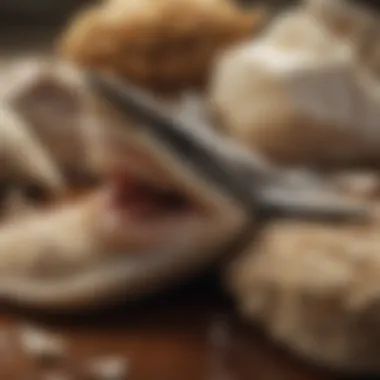Discover the Enchanting World of Shark Tooth Collecting


Rock and Fossil Identification
Shark tooth collectors often find themselves immersed in the world of rocks and fossils, which play a crucial role in understanding the origins and history of these intriguing specimens. When it comes to rock and fossil identification, enthusiasts must familiarize themselves with various types of rocks and fossils that commonly house shark teeth. These include sedimentary rocks like shale, limestone, and sandstone, known for preserving fossils due to their composition and formation over thousands of years. Furthermore, understanding the characteristics to look for in rocks and fossils is essential for identifying potential shark tooth deposits. Texture, color, and layering can all provide valuable clues for determining the presence of fossils. To aid in this process, collectors utilize specialized tools for identification such as magnifying glasses, chisels, and brushes, allowing them to carefully extract and examine fossils without causing damage.
Collecting Tips and Techniques
Effective collection methods are paramount in the world of shark tooth collecting to ensure a successful and rewarding experience. Enthusiasts adhere to best practices that prioritize preservation and ethical collection. When identifying prime collecting sites, factors such as proximity to ancient seabeds, geological formations, and water currents play a significant role in determining the likelihood of finding shark teeth. Additionally, learning how to safely extract specimens from rock formations without compromising their integrity is crucial. Utilizing tools like rock hammers, pry bars, and safety goggles enables collectors to excavate fossils meticulously while minimizing the risk of damage.
Preservation and Display
Once collected, preserving and displaying shark teeth are essential aspects that showcase the beauty and history encapsulated within these fossils. Preserving rocks and fossils involves employing techniques such as cleaning with mild solutions, removing excess sediment, and applying protective coatings to prevent decay. Proper storage methods, such as keeping specimens in a controlled environment with low humidity and minimal light exposure, help maintain the integrity of shark teeth over time. Creative ideas for displaying shark teeth include mounting them in shadow boxes, arranging them in thematic dioramas, or incorporating them into custom jewelry pieces, allowing collectors to share their passion with others while protecting their prized possessions.
Geological Insights
Delving deeper into the geological aspects of shark tooth collecting unveils a world rich in history and significance. Understanding geological formations and processes can provide valuable insights into how and where shark teeth are preserved. Exploring the historical significance of rocks and fossils sheds light on ancient ecosystems, climate changes, and the evolution of marine life over millions of years. Notable discoveries in the field of paleontology have furthered our understanding of shark tooth evolution and diversity, demonstrating the enduring fascination and relevance of these prehistoric treasures.
Introduction
In the vast world of shark tooth collecting lies a realm of intrigue and fascination that captivates enthusiasts and novices alike. This introductory section serves as the gateway to unveiling the secrets and wonders that abound in this unique hobby. Shark tooth collecting is not merely about acquiring artifacts but delving into a historical journey that connects us to the ancient oceans and mysterious creatures that once roamed our planet. By exploring the significance, methods, and insights of this practice, collectors gain a deeper appreciation for the natural world and the marvels it holds within its depths. This article aims to shed light on the art and science of shark tooth collecting, offering a comprehensive guide for those seeking to embark on this mesmerizing adventure. From the historical significance of shark teeth to the techniques used in their discovery, this exploration will navigate through the intricate world of collecting, providing valuable knowledge and practical tips for enthusiasts to enhance their experience. Join us as we dive into the mesmerizing world of shark tooth collecting and uncover the hidden treasures that await discovery.
Understanding Shark Teeth
Shark teeth play a pivotal role in the world of shark tooth collecting, serving as the key focal point for enthusiasts and researchers alike. Understanding the various aspects of shark teeth is essential for identifying species, determining diets, and comprehending the evolution of these fascinating creatures. By delving into the anatomical features and types of shark teeth, collectors gain invaluable insights into the behavior, habitat, and ecological roles of different shark species.
Anatomical Features


Shark teeth exhibit a diverse range of shapes and sizes, each adapted to specific feeding behaviors and functions within the shark's mouth. For example, the triangular shape of the great white shark's teeth is ideal for grasping and tearing prey, while the needle-like teeth of a mako shark are designed for swift cutting through flesh. Understanding these anatomical features not only aids in species identification but also provides clues about the dietary preferences and hunting techniques of various sharks. Moreover, examining the serrations, cusplets, and root structures of shark teeth can reveal valuable information about the age and health of individual sharks, offering a deeper understanding of their life history.
Types of Shark Teeth
Shark teeth can be broadly categorized into several main types, including serrated, smooth-edged, triangular, and cone-shaped teeth. Each type is uniquely suited to the feeding habits and prey preferences of different shark species. Serrated teeth, for instance, are effective for slicing through tough prey like fish and marine mammals, while triangular teeth are well-suited for gripping and cutting. By studying the different types of shark teeth, collectors can identify the shark species they originated from, reconstructing the ecological roles and interactions of these predators in marine ecosystems. Furthermore, recognizing the diversity of shark tooth types allows enthusiasts to appreciate the evolutionary adaptations that have shaped these remarkable predators over millions of years.
The Art of Shark Tooth Collection
In the vast realm of shark tooth collecting, 'The Art of Shark Tooth Collection' stands out as a crucial aspect that demands attention and appreciation within this comprehensive guide. It is not merely about gathering teeth but rather a meticulous craft that requires skill, knowledge, and dedication. This section delves into the significance of honing one's expertise in this art form and the rewards it brings. By understanding the art behind shark tooth collection, enthusiasts can elevate their experience to a whole new level.
Choosing the Right Locations
Selecting the appropriate locations for shark tooth collection is paramount to success in this endeavor. The quest for shark teeth is intrinsically tied to specific geographical areas that are rich in fossil deposits or known for their shark populations. Factors such as geological formations, sediment composition, and proximity to oceans play a pivotal role in determining where collectors should focus their efforts. By exploring the significance of choosing the right locations, enthusiasts can maximize their chances of finding rare and valuable shark teeth.
Tools of the Trade
Equipping oneself with the right tools is fundamental to the art of shark tooth collection. From basic necessities like sieves and shovels to more advanced equipment such as sifters and screens, having the proper gear can significantly enhance the efficiency and effectiveness of the collection process. This section explores the benefits of utilizing various tools and how each item contributes to the overall success of a collecting expedition. Understanding the tools of the trade empowers collectors to approach their hobby with precision and thoroughness.
Techniques for Finding Shark Teeth
Mastering the techniques for finding shark teeth is a skill that can make a substantial difference in the quality and quantity of discoveries. From scanning the surface of beaches to diving deep into underwater caverns, each technique offers a unique approach to uncovering these prehistoric treasures. By delving into different methodologies such as sifting, snorkeling, and diving, collectors can broaden their horizons and increase their chances of stumbling upon rare specimens. This section highlights the importance of honing these techniques and adapting them to diverse environments, thereby enriching the overall experience of shark tooth collection.
Preserving and Displaying Shark Teeth
In the realm of shark tooth collecting, one cannot overlook the critical aspect of preserving and displaying these fascinating relics. Preserving shark teeth is crucial not only for their longevity but also for maintaining their aesthetic appeal. Proper preservation prevents deterioration and ensures that these valuable specimens remain intact for generations to come. Displaying shark teeth is equally important as it allows enthusiasts to showcase their collections proudly while also sharing the beauty and marvel of these ancient treasures with others.
Preservation involves careful cleaning and maintenance to safeguard the integrity of the teeth. Understanding the composition of shark teeth is essential to determine the appropriate cleaning methods. Gentle cleaning with mild soap and water, avoiding harsh chemicals, is recommended to prevent damage. Regular maintenance, such as gentle brushing to remove dirt and debris, can help preserve the natural shine and color of the teeth.


Arranging collections thoughtfully is not only visually appealing but also serves a practical purpose. Grouping teeth by species, size, or geographic origin can add a systematic and organized look to the display. Using specialized display cases or shadow boxes can protect the teeth from dust and damage while allowing them to be viewed safely. Incorporating labels with relevant information about each tooth can enhance the educational value of the display, providing insights into the diverse world of sharks and their teeth.
Investing time and care in preserving and displaying shark teeth is a rewarding endeavor that enriches the appreciation for these prehistoric marvels. Whether it is for personal enjoyment or educational purposes, properly preserving and displaying shark teeth ensures that their beauty and significance endure for years to come.
Significance of Shark Tooth Collecting
Significance of Shark Tooth Collecting
Shark tooth collecting holds a profound significance that transcends mere hobbyist interests. In this article, we delve into the intricate world of shark tooth collecting, exploring its rich history, cultural importance, and scientific value. Understanding the significance of this activity allows enthusiasts to appreciate its role in both ancient and modern contexts. By highlighting the key points discussed throughout this guide, we aim to shed light on the multifaceted nature of shark tooth collecting.
Historical and Cultural Perspectives
Historical and Cultural Perspectives
The historical and cultural facets of shark tooth collecting provide invaluable insights into how this practice has evolved over time. From ancient civilizations using shark teeth for ceremonial purposes to contemporary societies valuing them as symbols of strength and protection, the journey of shark tooth collecting is steeped in cultural significance. By examining the historical narratives and cultural symbolism associated with shark teeth, enthusiasts can develop a deeper appreciation for the art of collecting these prized artifacts.
Scientific Value
Scientific Value
Beyond their cultural and historical allure, shark teeth also offer substantial scientific value. These fossilized remains serve as critical tools for studying ancient marine ecosystems, understanding evolutionary processes, and unraveling the mysteries of prehistoric shark species. By analyzing the structure, composition, and diversity of shark teeth, researchers can piece together a comprehensive picture of our planet's past. This section will explore the remarkable scientific contributions that shark teeth make to fields such as paleontology, zoology, and geology.
Challenges and Rewards
In the world of shark tooth collecting, enthusiasts encounter a myriad of challenges and are rewarded with unique experiences. One of the primary challenges faced by collectors is navigating the vast and often unforgiving environments where shark teeth can be found. It requires patience, determination, and a keen eye to spot these treasures amidst sand, rocks, and underwater terrain. Additionally, competing with other collectors for prime hunting spots adds a competitive edge to the hobby, pushing enthusiasts to hone their skills and strategies for a successful find.
On the flip side, the rewards of shark tooth collecting are abundant and gratifying. The sheer excitement of uncovering a rare or perfectly preserved shark tooth is unparalleled. Each discovery carries a sense of accomplishment and marvel at nature's wonders, fostering a deep connection with the past and the mysterious world of sharks. Moreover, forming a community with fellow collectors allows for knowledge sharing, camaraderie, and the chance to trade or showcase prized specimens, enhancing the overall experience of shark tooth collecting.


Obstacles in Shark Tooth Collection
Shark tooth collection comes with its fair share of obstacles that enthusiasts must overcome in pursuit of their passion. One notable obstacle is the physical demands of collecting, as it often involves traversing rugged terrains, battling harsh weather conditions, and enduring long hours of searching. This physical exertion can be taxing, requiring collectors to be in good physical shape and adequately equipped for the challenges presented.
Another obstacle faced by shark tooth collectors is the competition and scarcity of prime hunting locations. Popular sites may be overcrowded, limiting opportunities for new discoveries and increasing the pressure to secure valuable finds. Adaptability and persistence are key qualities needed to thrive in this competitive environment and to succeed in the quest for exceptional shark teeth.
Joy of Discovery
Amidst the challenges and obstacles, the joy of discovery reigns supreme in shark tooth collecting. The thrill of stumbling upon a pristine Megalodon tooth or a rare species' dentition invokes a sense of wonder and awe. Each discovery holds the potential to unlock mysteries of the ancient oceans and provides a tangible link to prehistoric creatures.
Furthermore, the joy of discovery extends beyond the physical specimens to the knowledge gained and connections formed through exploration. Delving into the history and significance of each tooth, learning about different shark species, and sharing experiences with fellow collectors create a rich tapestry of enjoyment and intellectual stimulation. The joy of discovery transcends the act of collecting itself, shaping a deeper appreciation for nature's marvels and our place within it.
Ethical Considerations
Importance of Ethical Considerations
In the realm of shark tooth collecting, ethical considerations play a pivotal role in upholding the integrity of the practice. It is imperative to understand the significance of ethical conduct when engaging in this hobby to ensure the preservation of marine ecosystems and the sustainability of shark populations. By adhering to ethical guidelines, collectors can contribute to environmental conservation efforts and promote responsible collection practices. Furthermore, ethical considerations underscore the importance of respect for wildlife and natural habitats, emphasizing the need for ethical decision-making throughout the collecting process.
Benefits of Ethical Considerations
Embracing ethical considerations in shark tooth collecting yields numerous benefits, transcending beyond personal gratification. Ethical practices enable collectors to make informed choices that prioritize environmental well-being over personal gain, fostering a sense of responsibility towards marine ecosystems. Additionally, incorporating ethical standards into collection activities fosters a sense of community among collectors who share a mutual commitment to sustainability and conservation. By promoting ethical considerations, collectors can actively participate in safeguarding marine biodiversity and promoting ethical stewardship.
Considerations about Ethical Considerations
When delving into the ethical aspects of shark tooth collecting, it is essential to consider the potential implications of unethical practices on marine environments and shark populations. Circumspect collectors recognize the ethical dilemmas surrounding the commercialization of shark teeth and strive to minimize negative impacts through sustainable collection methods. Moreover, ethical considerations encompass broader issues such as habitat destruction, overexploitation, and ecosystem disturbance, prompting collectors to adopt ethical frameworks that prioritize environmental preservation. By reflecting on ethical considerations, collectors can cultivate a greater appreciation for marine life and contribute positively to conservation initiatives.
Conclusion
As we draw to a close in our exploration of the fascinating world of shark tooth collecting, it becomes evident that this hobby is not merely about finding and preserving artifacts but about delving into the depths of history, culture, and science. The importance of this topic within this comprehensive guide lies in its ability to bridge the gap between past and present, offering enthusiasts and novices a chance to connect with the mysteries of the ocean's apex predators like never before.
Within this article, the Conclusion section serves as the synthesis of all the key insights and knowledge shared throughout. It encapsulates the essence of shark tooth collecting, emphasizing its significance as more than just a pastime but a window into ancient ecosystems and evolutionary processes. By highlighting the thrill of discovery and the joy of learning about these relics, the Conclusion instills a sense of wonder and awe in readers, inspiring them to continue exploring the depths of this unique hobby.
Furthermore, the Conclusion section sheds light on the benefits of shark tooth collecting, not only in terms of personal enjoyment and satisfaction but also in the realm of scientific research and cultural appreciation. By uncovering the historical and cultural perspectives surrounding shark teeth, collectors can gain a deeper understanding of human interactions with the marine world throughout the ages, adding layers of meaning to their treasured finds.







